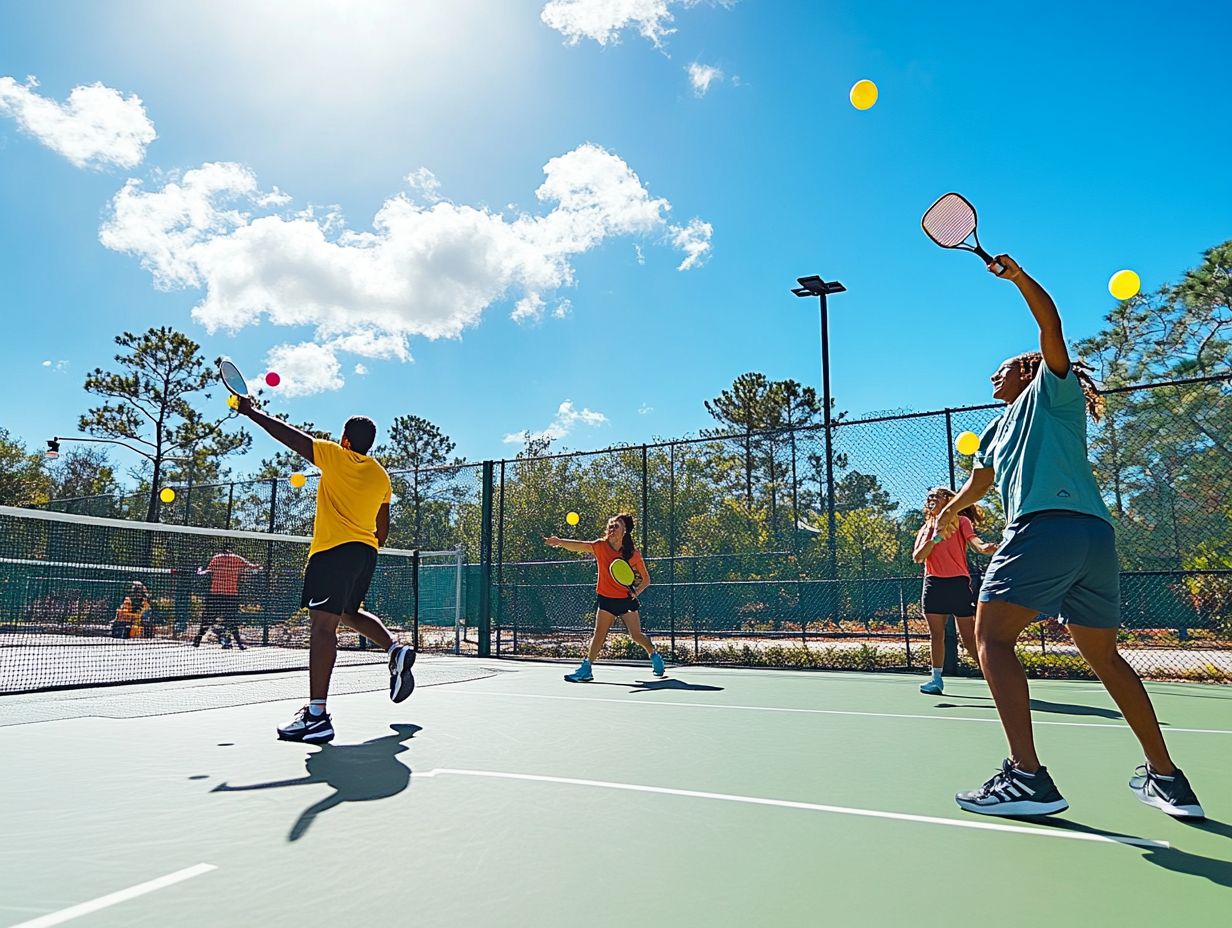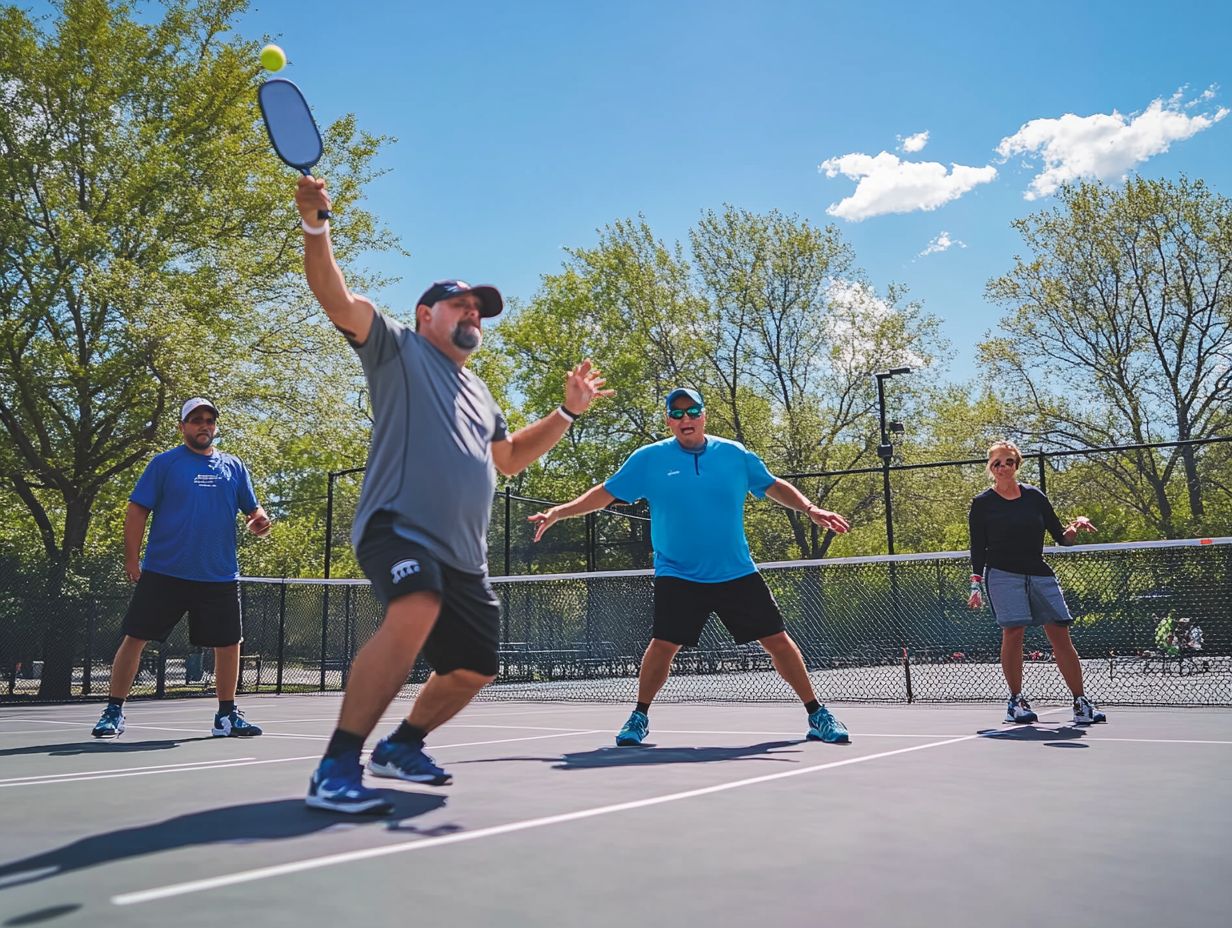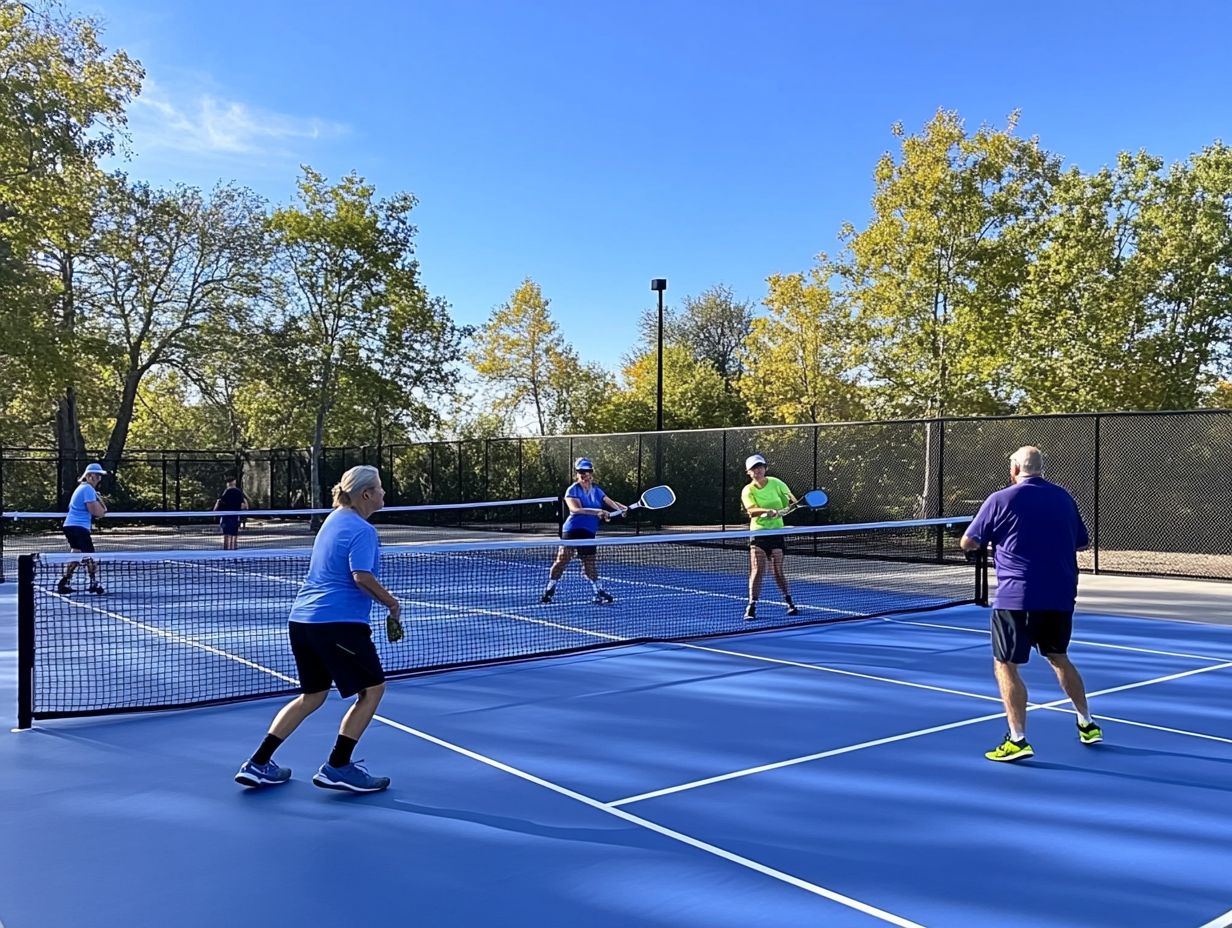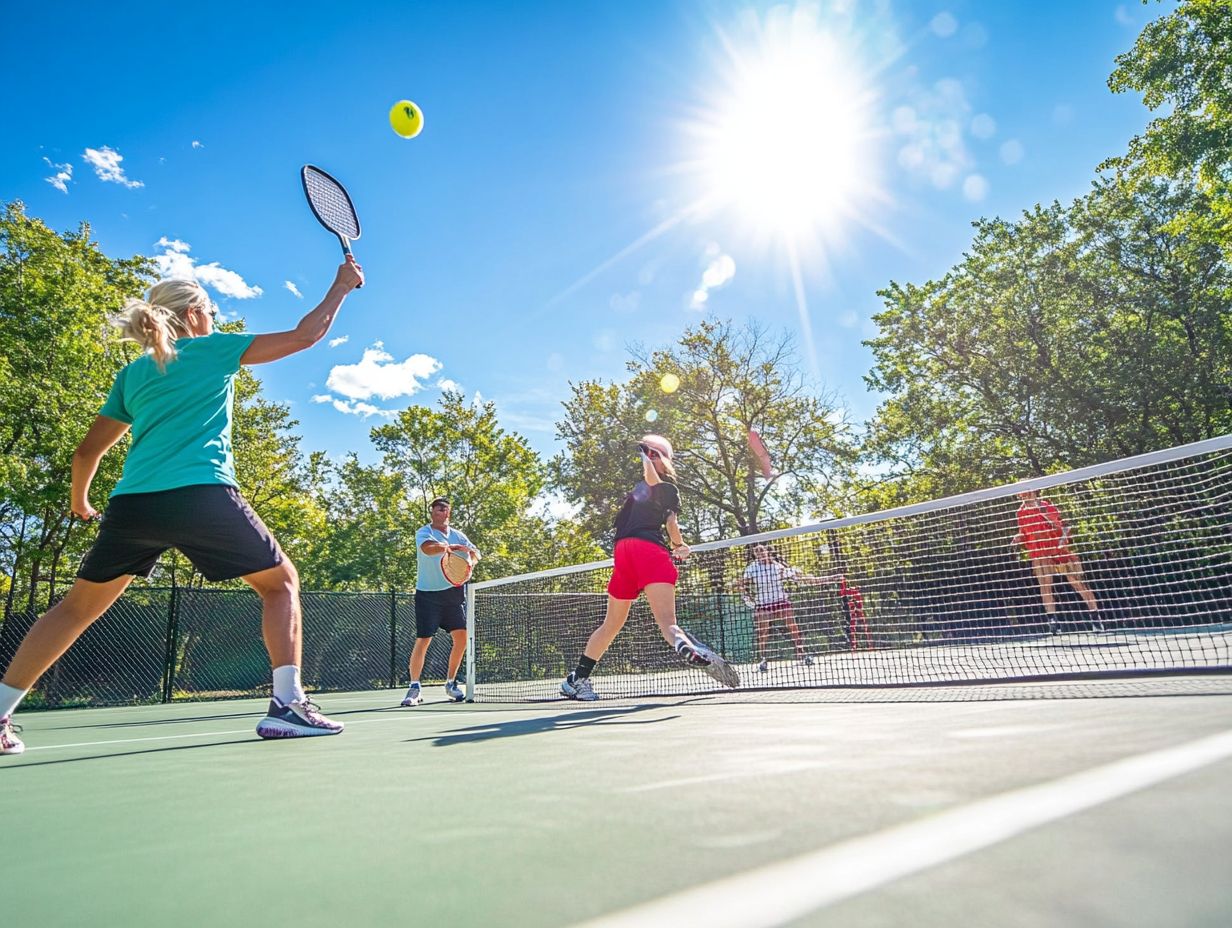Understanding the basic rules and equipment of pickleball is essential for both beginners and advanced players. This sport combines elements of tennis, badminton, and ping pong and is played on a court with a net. Familiarity with the necessary equipment, including paddles, balls, and proper court positioning, is crucial for mastering the sport’s fundamental rules.

Pickleball encompasses a variety of shots, such as forehand and backhand strokes, serves, volleys, and smashes. Knowing how and when to utilize these shots effectively, as well as mastering serving techniques and court strategies, can significantly enhance a player’s ability to win against opponents.
Plus physical and technical skills, a player’s mental acuity and decision-making abilities are vital for success in pickleball. These skills involve predicting an opponent’s next move, determining the optimal distance from the net, and swiftly deciding which of the three basic shots to execute. Proper etiquette, such as consistently and clearly announcing the score and treating opponents with respect, is also an important aspect of the sport.
While the rules for competitive and recreational pickleball are generally the same, most competitive tournaments have specific regulations. These may include guidelines on player conduct, match forfeitures, eligibility criteria, line calling, and match formats.
Furthermore, pickleball is a physically demanding sport that requires players to maintain a high level of fitness, which can be achieved through exercises aimed at building endurance, strength, flexibility, and agility.
Essential Drills for Beginners
Essential drills for beginners in pickleball are crucial for developing the game’s fundamental skills, such as serving and returning, volleying, and footwork. These beginner drills help enhance shot accuracy and foster a solid understanding of court positioning and net play, which are vital for effective gameplay.
Establishing a practice schedule for beginners not only improves player fitness but also provides regular opportunities for skill evaluation and enhancement, allowing new players to track their progress and build confidence in their game.
Improve Your Serve and Return
Here are various techniques, drills, and coaching tips for improving serve and return in pickleball. With consistent practice, players can enhance their technique and make necessary adjustments based on feedback from coaches, ultimately elevating their overall performance and providing them with an advantage in competitive situations. Since the serve and return are the two most fundamental aspects of the game, players should prioritize them during practice.
Drills for Serving:
- Types of Serves: Players should practice different types of serves, including:
- Topspin Serve
- Slice Serve
- Kick Serve
- Flat Serve
- Placement and Precision: Focus on consistent placement by targeting specific areas of the court. Gradually reduce the size of the target area to improve precision.
Drills for Returning:
- Types of Returns: Players should practice various types of returns, such as:
- Drive Return
- Lob Return
- Slice Return
- Chip Return
- Varying Return Placement: Work on varying the placement of your return by targeting different areas of your opponent’s court and using angles to create opportunities.
Drills for Improving Mechanics:
Players should engage in drills that focus on mechanics to enhance their serve and return, including:
- Shadow Swings: Practice without the ball to concentrate on form.
- Ball Toss Drills: Work on the toss separately to improve timing.
- Target Practice: Aim serves and returns at specific targets.
- Reaction Drills: Partner with someone who can return the ball quickly to help improve timing and anticipation.
Drills for Improving Footwork and Timing:
Footwork drills are essential for enhancing serve and return performance, including:
- Ladder Drills: Utilize a ladder or markers to improve foot speed and coordination.
- Cone Drills: Set up cones in various patterns to practice acceleration, deceleration, and direction changes.
- Shadowing: Practice without a ball to focus on footwork and positioning.
Drills for Improving Shot Selection:
Incorporate a combination of drills and controlled practice games to refine shot selection:
- Scrimmages: Play games with specific goals for each play.
- Scenario Drills: Set up specific situations to practice shot selection in a controlled environment.
- Controlled Games: Focus on specific aspects of the game during practice.
Drills for Improving Strategic Thinking:
Enhance situational awareness during practice games by:
- Match Scenario Simulations: Compete against opponents with varying play styles and strengths.
- Practicing Different Scenarios: Work on scenarios such as trailing in points or facing a stronger opponent.
Drills for Improving Adaptability:
Utilize mental exercises to enhance adaptability during practice sessions, including:
- Mindfulness Exercises: Focus on being present and aware of your surroundings.
- Visualization Techniques: Mentally visualize plays before they occur.
- Staying Flexible: Practice being open to changes in strategy and adapting quickly.
Drills for Improving Video Analysis:
Leverage video analysis to improve mechanics for serving and returning. This includes:
- Reviewing Footage: Analyze recorded sessions to identify areas for improvement.
- Analyzing Different Aspects: Examine various elements of the serve and return, such as timing, placement, and follow-through.
- Getting Feedback: Seek input from coaches or experienced players for further development.
Mastering the Dink Shot

Mastering the dink shot is essential in pickleball, as it serves as a key tool for net play and controlling the pace of the game. A dink shot is a soft, precise shot strategically placed just over the net into the opponent’s court.
By incorporating specific strategy drills focused on footwork and placement, players can enhance their ability to execute the dink shot consistently, making it a vital weapon in both recreational and competitive play.
Proper footwork is crucial for positioning oneself at the net, enabling players to react quickly and maintain their balance while preparing for the shot. During drills designed to establish a solid foundation for effective dinks, players should practice lateral movements and quick pivots.
Additionally, understanding the angle of the paddle and how to grip it can further refine their technique. Players should aim to release the ball just above the net while swinging down the front of the paddle, ensuring that the shot clears the net while maintaining a low trajectory.
Regularly incorporating these tactical elements into practice sessions not only builds muscle memory but also enhances a player’s strategic approach to gameplay. This diligent practice ensures that players can consistently leverage the dink shot as a means of controlling points during matches.
Advanced Drills for Experienced Players
Advanced drills for experienced players looking to improve their pickleball game emphasize strategy sessions and the practice of advanced techniques aimed at enhancing reflexes, endurance, and strategic thinking. By developing quick decision-making skills and applying them during training, players can implement these advanced techniques in various game scenarios.
This approach fosters a strong mental focus, which can be particularly beneficial during tournaments and high-stakes matches.
Strategies for Winning Doubles Matches
In pickleball, doubles matches are won by teams that recognize the significance of teamwork, court positioning, and effective communication with their partners. Successful players are those who can execute strategic match play, where their movements and shots are synchronized, allowing them to make decisions based on their partner’s positioning and performance.
As highlighted in the previous section, playing matches with a partner and collaboratively developing a strategy is the best approach to enhancing decision-making and coordination skills. The most efficient way to ensure that players are aware of each other’s actions is through clear communication. Players should express their intentions before each shot to ensure they are aligned.
Additionally, court positioning is critical to success in doubles play; maintaining the correct formation—such as side-by-side or one-up, one-back—can significantly influence performance. Encouraging each other and providing constructive feedback during rallies fosters a positive atmosphere, helping players collaborate effectively.
Mastering the Third Shot Drop

The third shot drop in pickleball is crucial because it creates opportunities for net play and allows a player to control the pace of the game. This shot occurs immediately after the serve and return, making solid ball control and an understanding of when to transition from the baseline to the net essential for success.
Practice routines that focus on the third shot drop and its effective use during matches can help players master this technique and enhance their overall pickleball skills, resulting in more won rallies.
Tips for the Importance of the Third Shot Drop
- Third Shot Drop Timing: It is vital to practice the timing of when to execute a third shot drop versus when to play aggressively. A player must be aware of their own position as well as that of the opposing team on the court. If the receiving team remains at the baseline waiting for the ball, it indicates they are not yet in a position to attack, as they have not formed the ‘kitchen barrier.’ This situation signals that it is an appropriate time to drop the shot.
- Third Shot Drop Paddle Grip: Softening the grip on the paddle enhances feel and touch, allowing the player to gently let the ball roll off the paddle and drop just over the net into the desired location (drop zone).
- Third Shot Drop Goals: Players should aim for a high trajectory on the ball, keeping it 2 to 3 feet above the net. This will ensure that the ball drops quickly on the other side, making it difficult for the opposing team to attack and gain an advantage.
Want to Improve Your Third Shot Drop? Try These Drills
- Target Practice: Set up cones or other targets in the drop zone to practice hitting the ball consistently in that area. This exercise will help develop accuracy and control for the third shot drop. The cones can be repositioned to different locations to incorporate movement into the drills.
- Game-Like Scenarios: Practice the third shot drop in game-like situations with a partner or coach. This can involve hitting the ball back and forth while incorporating various elements such as movement, varying speeds, and specific targets. This approach helps players develop awareness of what to expect from opponents and how to assess the current position of the ball in relation to the net.
- Practice Makes Perfect: Incorporate the third shot drop into regular practice routines. Consistent practice will improve technique and help players master this important skill.
Exercises to Improve Your Pickleball Game
Exercises specifically designed to enhance your pickleball game are a vital component of a player’s overall fitness routine and play a significant role in refining on-court performance.
Strength and conditioning exercises help develop the muscle groups utilized in pickleball, while mobility and flexibility exercises enhance movement and agility during play. This combination of exercises results in improved endurance and reaction time, ultimately leading to a greater enjoyment of the game.
Strength and Conditioning
Integrating strength and conditioning into your pickleball training regimen is essential for enhancing player fitness and minimizing the risk of injuries during competitive games. A strength training program tailored specifically for pickleball builds muscle power and endurance, enabling athletes to sustain high levels of performance throughout the match.
Injury prevention strategies, including conditioning exercises and muscle strengthening techniques, are vital components of a pickleball training regimen, ensuring that athletes’ bodies can withstand the demands of competitive play.
Incorporating specific routines such as resistance training, agility drills, and core stability exercises further enhances overall athleticism. For pickleball players, leg and core strength are particularly important; therefore, strength-building exercises like squats and lunges are crucial for developing strength and improving balance, which are necessary for executing quick lateral movements on the court.
Additionally, incorporating cardiovascular training elements, such as interval training, can help build endurance, allowing athletes to maintain their energy levels during lengthy matches. Flexibility routines, including dynamic stretching and yoga, contribute to joint health and reduce the risk of injury.
By engaging in these fitness components, athletes not only boost their performance on the court but also safeguard their long-term physical well-being.
Agility and Footwork

Agility and footwork training are essential for pickleball players looking to enhance their performance and reaction times during matches. These skills are equally important for both moving across the court and striking the ball effectively.
Incorporating a variety of drills into their training regimen, such as ladder drills to improve foot speed and cone drills to enhance lateral movement, can provide significant benefits to athletes. Exercises like shuttle runs and side shuffles enable players to develop quick transitions between shots, allowing them to position themselves effectively for returning the ball.
By integrating these agility and footwork drills into their routines, players will experience improved stability, which is crucial for striking with power and maintaining balance during fast-paced exchanges.
Tips for Practicing and Improving Your Pickleball Game
Effective practice routines and improvement plans are essential for consistently enhancing your pickleball game. Regular practice enables players to continuously refine their skills while integrating feedback from coaching and fellow players to foster their development.
By focusing on specific areas of improvement during drills, players can gradually elevate their overall performance and work towards achieving their individual peak on the court.
Creating a Practice Routine
A structured practice routine is essential for players of all levels to ensure consistent improvement in pickleball. By setting specific goals and managing time effectively, players can concentrate on enhancing key areas such as shot accuracy, footwork, and strategy. Incorporating elements that increase enjoyment and motivation into practice can help maintain a positive mindset and encourage lifelong engagement with the sport.
To create a balanced routine, players should begin by assessing their current skill levels and identifying specific areas for improvement. This may involve scheduling practice sessions that alternate between drills focused on fundamental skills and more advanced techniques, ensuring that players of all skill levels can benefit from their training.
Utilizing a time management strategy, such as the Pomodoro Technique, can help maximize productivity during practice sessions. Regularly assessing progress and adjusting goals as players advance will not only keep motivation levels high but also facilitate the development of a personalized practice schedule that reflects individual growth.
A well-structured practice routine can serve as an exciting roadmap for skill development in pickleball.
Mental Preparation and Focus
Mental preparation and focus play a crucial role in a player’s success on the pickleball court, significantly influencing both performance and decision-making during matches. Players can enhance their mental acuity by employing techniques from sports psychology.
For instance, visualization allows athletes to imagine their optimal performance by creating a mental picture of the successful shots and plays they wish to execute, thereby boosting their confidence. Mindfulness exercises promote awareness of current sensations and emotions, reducing the likelihood of distractions that can disrupt focus. Additionally, developing pre-match routines can help players enter the right mental state by providing a sense of familiarity and alleviating nerves.
By utilizing these techniques, players can maximize their mental resources, enabling them to better adapt to the ever-changing demands of the game.

Pickleball’s more than a game to me—it’s a passion. I write, sharing its highs and lows, the thrills and the lessons. Some tales might draw you to the court, while others give a hint of the game’s magic. So, curious about my journey? Ready to dive deep into the world of pickleball with me? Let’s go.
